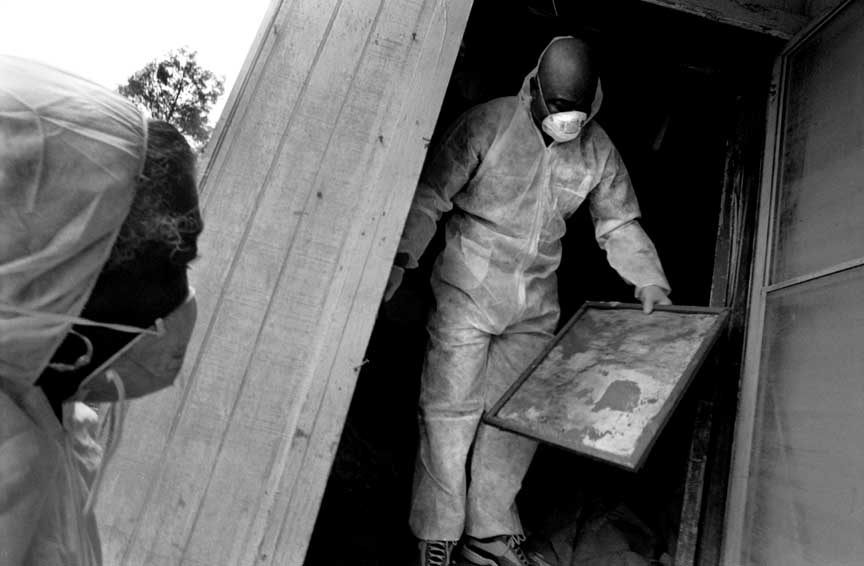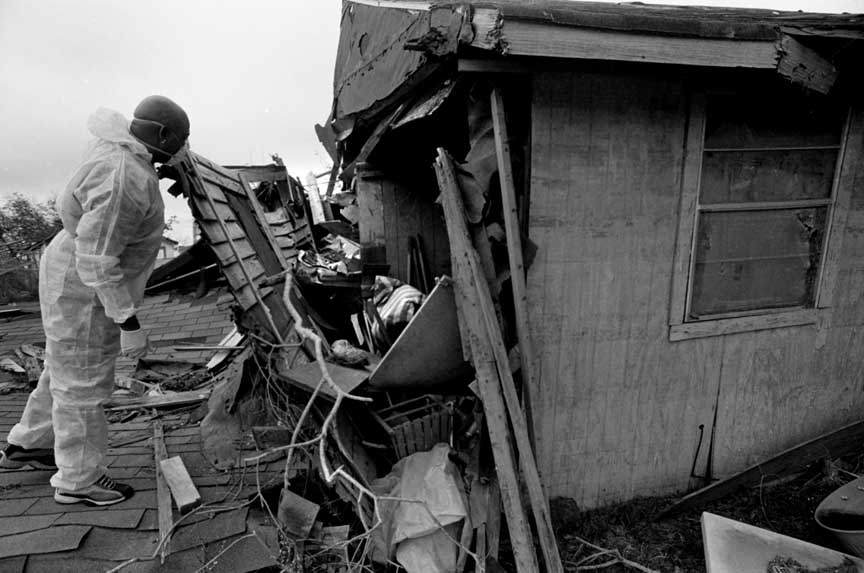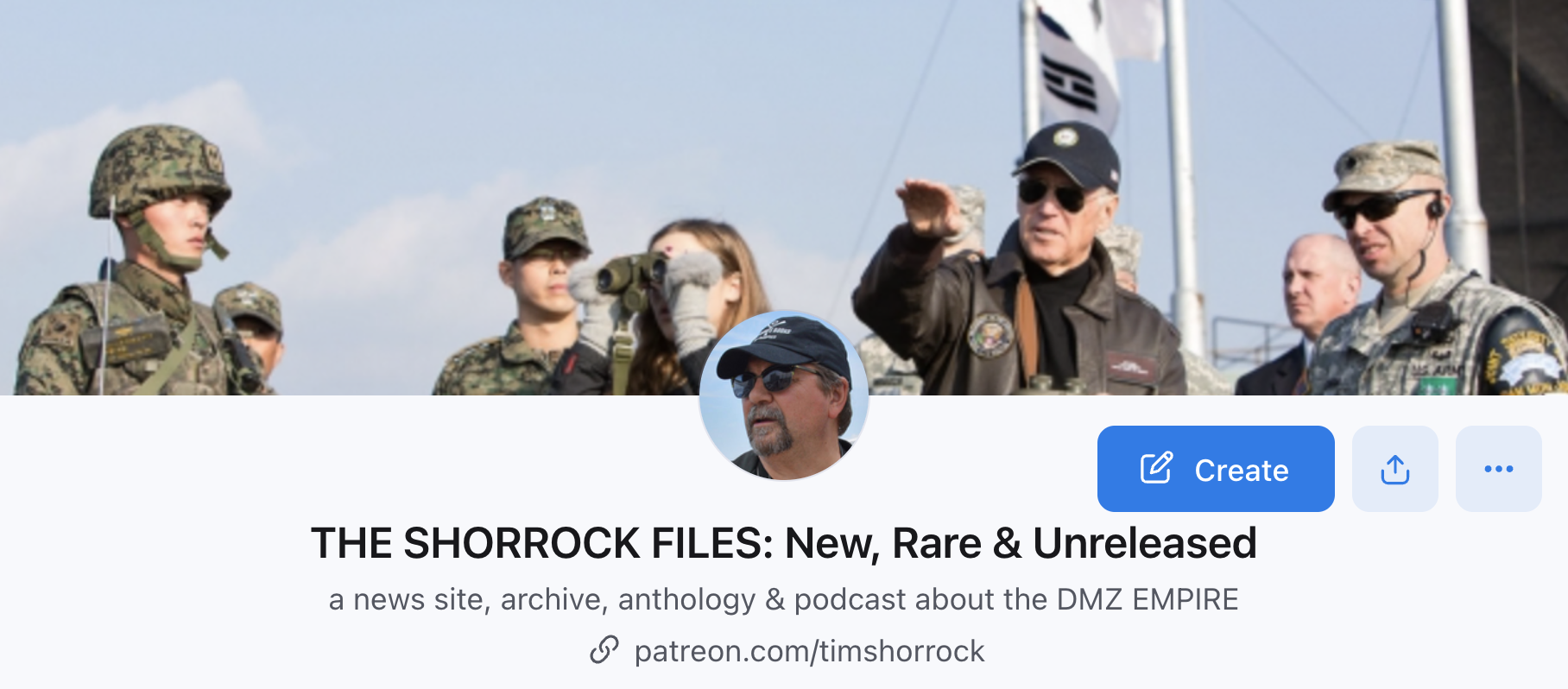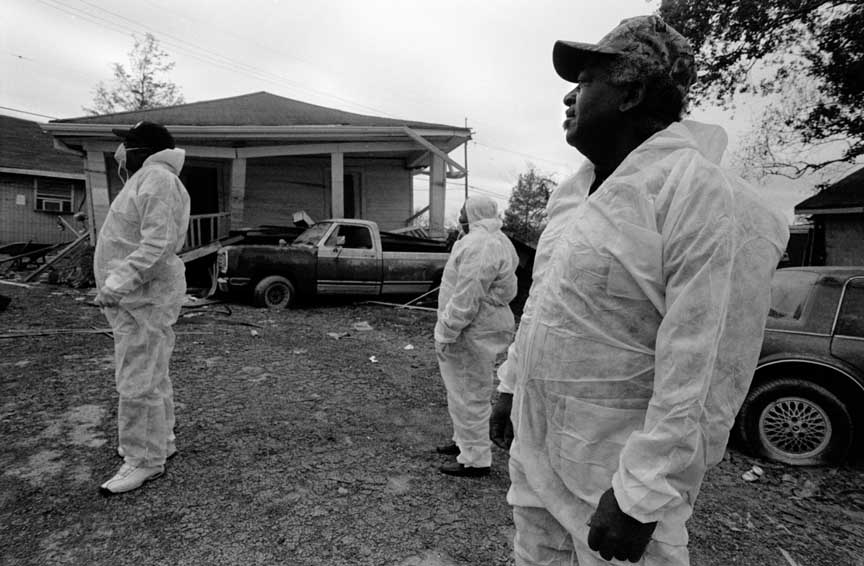
Covering Hurricane Katrina was one of the hardest assignments in my 30 years in journalism. I wrote this story after spending two grueling days walking through the Lower Ninth Ward, accompanying families who were coming back there for the first time since the calamity. I will never forget the strength and dignity of the people I met during those days, and often wonder what became of them. My story was published by the Institute for Southern Studies‘ Gulf Coast Reconstruction Watch. The photos were shot by my friend and colleague, Kike Arnal.
VOICES FROM THE NINTH WARD
By Tim Shorrock
NEW ORLEANS – Michelle McKenney Jones stood last Friday, December 2, outside of the home in New Orleans’s Lower Ninth Ward built by her grandfather in 1953 and where her mother lived until Hurricane Katrina and Rita swept through the area. It was only the second day that local residents were allowed into her neighborhood, which was demolished by flood waters spilling from the nearby levee that was breached during Katrina.
Jones, who now lives in Nashville, sighed as she surveyed the house, which was knocked off its foundations and is now uninhabitable. The social impact of the disaster in the Ninth Ward, she said, was compounded because this neighborhood once had the highest percentage of black homeownership in the entire Parish of Orleans. Then she paused as her emotions caught up with her.
“You’ve got to be our voice,” she told me and Kike Arnal, the photographer who was accompanying me. “This community doesn’t have a voice. Nobody seems to be listening to us. Represent us, please.” As she spoke, tears filled her eyes and rolled down her cheeks. Kike and I stood with her in silence for a minute, trying to share her grief, and assured her that we would hold her words in our hearts.
That conversation was one of the most poignant I experienced in two recent visits I made to New Orleans, where I’ve been working on assignment for Mother Jones magazine. Jones’s plea underscored the tremendous responsibility I feel as a journalist to share what I’ve learned here with the American public, which is fast losing interest in New Orleans as the media shifts its focus to other concerns and government agencies continue to demonize the African-Americans who make up the majority of this wounded but wonderful city.
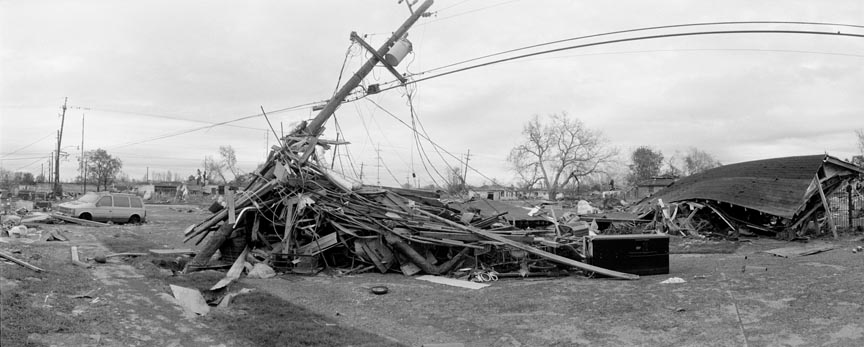
I spent 10 days in New Orleans in late October and early December, 2005 During my first visit, the streets of the Lower Ninth Ward were closed to the public. But it was possible to get a sense of the damage by visiting the Disaster Recovery Center at the intersection of North Claiborne and Caffin Avenues, where the Salvation Army and other private groups had set up tents and vans to provide food, water and other supplies to residents and the rescue workers still pulling bodies from houses in the neighborhood. Common Ground, the collective that runs a free clinic in New Orleans’s West Bank and a distribution center in the Ninth Ward, was also using the site for biweekly mobile clinics.
Throughout the area, in every direction, all I could see was complete devastation. Every structure in the Lower Ninth had been severely damaged, many of them obliterated. Cars and vans lay overturned and smashed, and some vehicles were pushed by the water into homes and storefronts, where they were buried amidst tons of debris. A dry, grey film of toxic mud covered every street and sidewalk, and spread into homes and storefronts; near the disaster center, the thickest mud was cordoned off with yellow tape reading “Caution: Chemical Spill.” Here and there a boat could be seen leaning incongruously where it was abandoned after the water receded. Refrigerators closed with large straps and filled with rotting food stood at busy street corners like silent sentries. Stray dogs ran through the area, apparently the only survivors of the flood. Piled on every street was garbage and waste. And posted on nearly every telephone pole was a sign from a local entrepreneur trying to make a killing off the suffering: “I Buy Homes, Any Location or Condition/Cash in Three Days.”
One of those taking advantage of Common Ground’s free medical services at the recovery center was Audrey Whittington, 54. She came over to the clinic’s tent after watching her two teenage sons receive tetanus shots from Jim, a Common Ground volunteer nurse from New Mexico. Although she said she hates needles, Whittington decided to get an injection anyway, and afterwards spoke to me about her experiences during and after Katrina.
Whittington left the Ninth Ward a few days before Katrina hit because she was sick, and went to Mississippi to be with her family and ride out the storm. “Once I got there, I was feelin’ good – so maybe that sickness was a sign, a blessing.” But after the levee broke, she watched in horror as her neighborhood was engulfed in water and people scrambled to be rescued. Later she learned that her best friend had died in the flood, inside her own home. But the body wasn’t found for weeks; after Rita came through, the family asked the National Guard to look for her. But the Guardsmen reported back they’d found nothing and wrote a large zero on the house indicating no bodies had been found. Then, nearly a month later, the woman’s sister went over to the house and found her.
“The government doesn’t tell you everything,” said Whittington, expressing the deep mistrust of the feds that is so common in this city. Her house, she said, “is completely gone.” Worse, because she’d put the house where she’d lived for 16 years up for sale just before the storm, she’d let the flood insurance lapse. Now all she has is a simple homeowner’s policy, and that is likely to cover just a fraction of her loss. Plus “FEMA only gives you so much.” But even if she comes up with enough money to rebuild, “there’s no way I can go to my house when the rest of the houses around are gone. You think I’m going to live in a neighborhood that’s just me? With a levee that could break? I just don’t know what to do.”
Earlier, Whittington had taken advantage of a tour bus that, courtesy of the city government, had been shuttling people around the Ninth Ward to allow them to see their neighborhoods. “Get on that bus, and what you’re gonna see gonna make you think you been in Vietnam,” she said. “There’s houses on top of houses, there’s cars on top of cars. It’s breathless to see something like that.” She turned to leave. “All we can do is hope and pray, keep your sanity and just ask God to give you strength to get you to the next step because this one’s gone” – meaning her neighborhood – she said. “But at least I’m alive.”
As we spoke, I noticed an Asian man sitting pensively on a chair behind us, taking in the scene. He identified himself as Win Saan, a former soldier with the South Vietnamese Army. He came to the United States in 1978, three years after the end of the war, and eventually settled in Kenner, a suburb of New Orleans. Until Katrina, he had a small medical practice with an office just around the corner from the Disaster Recovery Center. “We don’t have our clients anymore,” he said sadly. All his people are gone and living in places like Baton Rouge, New Iberia and Houston. I asked Win if he thought his patients might return to the Ninth Ward. “I don’t think so,” he replied. “If the levees are weak like that, they get scared.”
The next day, I ran into Clyde Bloodwirth, 69, picking up cleaning supplies at the Common Ground distribution center at the corner of Louise and North Robertson Streets. His house was just around the corner, in an area that was heavily damaged although not quite as badly as those in the Lower Ninth. Still, Bloodwirth’s story was a harrowing one. He and his wife didn’t evacuate the city and, when the water came, were trapped in their house with their daughter and three grandchildren.
After nearly 48 hours on their roof, they were taken by boat to a spot on Interstate 10, where they remained for five long days. “They had nothing for us up there,” Bloodwirth said of the disorganized and belated rescue efforts by the federal government. Then, like so many others, Bloodwirth and his family were flown by US transport planes to destinations they only learned about after they landed – first Atlanta, then Mobile and finally Houston. Bloodwirth was now living with his sister in Metarie, just outside of New Orleans, and returning to the city every day to begin repairing his house. He thinks he can make it livable again, but only after clearing out all the debris and gutting everything but the frame.
A month after this interview, I was in the Lower Ninth again, working with Kike on our feature for Mother Jones. On December 2, we drove to the Disaster Recovery Center, which by now had been taken over by FEMA, the Environmental Protection Agency and the Small Business Administration.
As before, the area was heavily protected by National Guard troops and New Orleans police, but this time there was the added presence of two armed officers from the Immigration Customs Enforcement division of the Department of Homeland Security. There were also four security personnel from Blackwater Inc., the North Carolina private security company that has made a fortune providing security to US officials and contractors in Iraq. Blackwater first showed up in New Orleans right after Katrina to protect the palatial homes of the wealthy.
Last week, however, Blackwater was guarding FEMA. Four young guards, wearing black shirts with Blackwater insignia, matching green chinos and the same wrap-around eyeshades, stood stiffly around the FEMA tables. FEMA couldn’t have tried harder to underscore its utter estrangement from the people of New Orleans and the private and public agencies providing relief to the city.
As Kike and I drove up, we spotted a family getting out of a van and pulling on white overclothes to protect themselves as they entered their homes for the first time since the storm. We asked them if we could accompany them, and they readily agreed. It was a family of four: Evelyn Gilbert, and her three sons, all in their 50s: Rhett, Gustaf and Daniel. I felt privileged to be with them on such a sacred moment. Kike and I followed them slowly down North Claiborne (where I had walked a month before only to be stopped by the National Guard) and into a little cul-de-sac near the canal. We stopped and got out in front of a long white house completely off its foundation. Next to it was a tiny blue structure, leaning crazily to one side with its roof caving in. It had been Evelyn’s home, and was built in 1978, she said; the rest of the family lived next door. The heavy line at the top of the roofs showed that both houses had been almost completely under water.
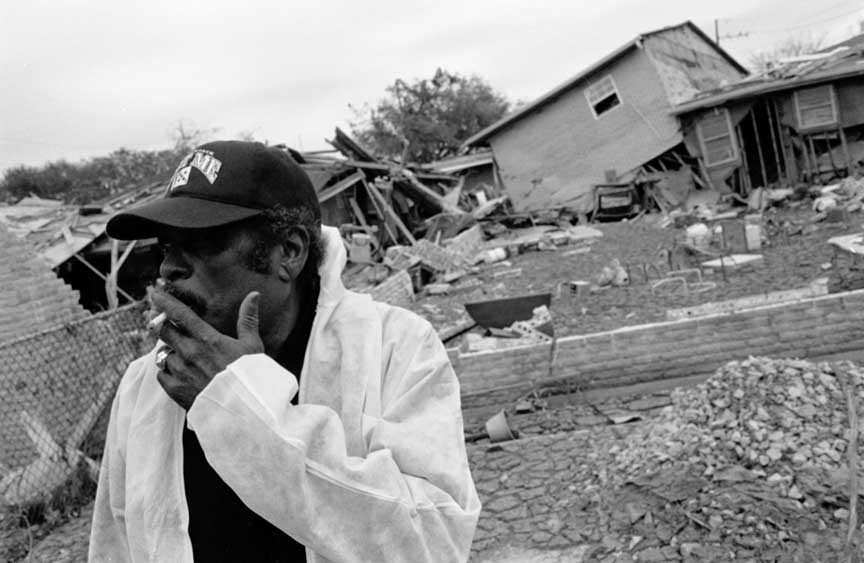
As the Gilbert brothers explored their property, I hung back, feeling like an interloper and trying to avoid being intrusive. After a while, I asked Evelyn, who didn’t want to go near her house, where she was when the water came. She told me she was evacuated on the Friday before the storm, and ended up in Houston; she’s now staying in Mississippi with family. She watched anxiously as her sons pushed open her front door and gingerly took a few steps inside the destroyed house. Finally, Rhett walked out carrying a portable barbeque. “We found something at least,” he said. “But it’s the only thing salvageable.” He dusted it off as best he could and loaded it into the van.
Gustaf and Daniel then went to look at their house as Rhett told me a little about the neighborhood. “I was born and raised here, and this is the only place I know,” he said. “I know this city like the back of my hand.” He motioned to the other broken structures near their property. “All these are kin-folk. Used to walk to the church over there, the store.” Now, he said, he lives in Dallas, and everywhere he walks he runs into another freeway; worse, the services he needs are far away. He had no idea if he and his family will return, or where his former neighbors are. Finished with their short tour, the Gilbert family shook hands with Kike and me and slowly drove away.
It was about half an hour later that we ran into Michelle Jones as she took in her mother’s house with a local carpenter. The house, which her grandfather had clearly taken great pride in, was first destroyed when the levee was blown up during Hurricane Betsy in 1965; after he rebuilt it, it lasted until Katrina, when it was destroyed again, this time for good. Mayor Ray Negin, who’s now telling the people of New Orleans to come back, should visit this area of the Ninth Ward, she told us; he might not be so optimistic if could see the catastrophe for himself.
“Represent us, please,” she said once again. As she turned to leave, her mother called out: “And pray for us.” We watched them drive off, the gray dust picking up behind them.
